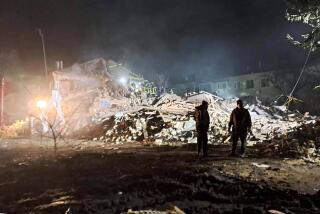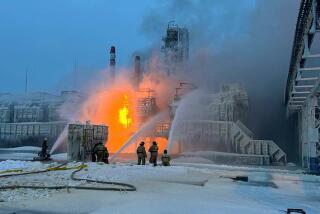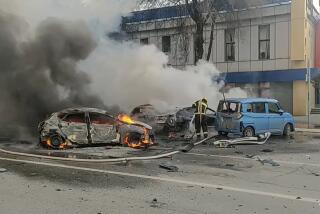Shell Kills 15 in Sarajevo Marketplace : Balkans: Dozens are wounded in one of the bloodiest attacks of the Serbian siege of the Bosnian capital.
SARAJEVO, Bosnia-Herzegovina — A howitzer shell crashed into a crowded marketplace Sunday, killing at least 15 people and wounding dozens in one of the bloodiest attacks of the Serbian siege of Sarajevo.
Rescue workers slung bodies into pickup trucks parked on bloodstained ground. Survivors screamed for family and friends as they wandered around market stalls strewn with limbs and other human remains.
“For a single shot to land so precisely as it did in the middle of that marketplace, it appears to have been intentionally targeted in that way at these innocent civilians,” said U.N. spokesman Fred Eckhard, whose offices are nearby.
Eckhard suggested the artillery round was fired from Serbian positions.
“It would be nice if we could turn ourselves into a police force and run up into the hills and grab those people and arrest them and bring them to justice,” he told the British Broadcasting Corp.
“Each side has promised they would stop the fighting. But it just doesn’t stop,” he said.
The attack in the Bosnian capital, under siege from Serbian forces opposed to Bosnian independence from the former Yugoslav federation, underscored deep tensions between the warring factions in the wake of last week’s London peace conference.
But both Serbs and Muslims reported the end of a Serbian siege of the eastern Bosnian town of Gorazde, which had been virtually cut off from the world for five months. Confusion remained, however, about the situation there.
Following an announcement a day earlier by Bosnia’s Serbian leader, Radovan Karadzic, that his forces were lifting the siege, Sarajevo radio quoted Bosnian government forces as saying they had “liberated” the town.
Karadzic charged that Bosnian government troops, mostly Muslims, had exploited the pullback of his soldiers.
“We have lifted the siege of Gorazde completely,” he said. “Our problem is that Muslim forces . . . are now attacking Serbian villages from which our troops have withdrawn.”
Fierce fighting around Gorazde forced U.N. officials to delay plans to dispatch an aid convoy.
“It appears to be extremely dangerous,” spokesman Eckhard said, adding that the convoy might leave Wednesday.
Gorazde, as the lone government holdout against Serbian insurgents in eastern Bosnia-Herzegovina, has been an emotional symbol of the war that began when the majority Muslims and Croats voted for independence from Yugoslavia on Feb. 29. As many as 100,000 people have been trapped there.
Reporters who accompanied the only U.N. relief convoy that has reached Gorazde said bombing had left no building unscathed, that there was no access to water, electricity, food or medicine and that the many wounded were operated on without anesthetics.
Sarajevo has also endured a nightmarish siege. In Sunday’s attack, more than 30 people were wounded when the 105-millimeter howitzer shell exploded in the market. The casualty toll was the worst since May 28, when mortar rounds killed at least 20 people in a bread line and wounded 100.
That attack prompted the European Community to impose trade sanctions on Serbia, which it accused of supporting Serbs fighting to carve their own state from part of Bosnia. U.N. sanctions on Serbia-dominated Yugoslavia followed May 30.
At least 8,000 people are known to have been killed in Bosnia since April--the full toll is believed to be many times higher--and 2 million people have become refugees.
More to Read
Sign up for Essential California
The most important California stories and recommendations in your inbox every morning.
You may occasionally receive promotional content from the Los Angeles Times.










